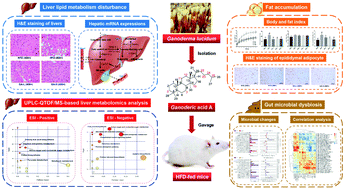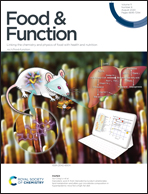Ganoderic acid A from Ganoderma lucidum ameliorates lipid metabolism and alters gut microbiota composition in hyperlipidemic mice fed a high-fat diet†
Abstract
Ganoderic acid A (GA) is one of the most abundant triterpenoids in Ganoderma lucidum, and has been proved to possess a wide range of beneficial health effects. The aim of the current study is to investigate the amelioration effects and mechanism of GA on improving hyperlipidemia in mice fed a high-fat diet (HFD). The results showed that GA intervention significantly inhibited the abnormal growth of body weight and epididymal white adipose tissue (eWAT), prevented the hypertrophy of epididymal adipocytes, and ameliorated the biochemical parameters of serum and liver related to lipid metabolism in HFD-fed mice. Histological analysis also showed that the excessive accumulation of lipid droplets in the liver induced by HFD-feeding was greatly alleviated by GA intervention. In addition, GA intervention also increased the level of short chain fatty acids (SCFAs) in the intestine and promoted the excretion of bile acids (BAs) through feces. High-throughput sequencing of bacterial full-length 16S rDNA revealed that daily supplementation with GA made significant structural changes in the gut microbial population of mice fed with HFD, in particular modulating the relative abundance of some function related microbial phylotypes. The relationships between lipid metabolic parameters and gut microbial phylotypes were also revealed by correlation analysis based on a heatmap and network. The result showed that 46 key gut microbial phylotypes (OTUs) were markedly correlated with at least one lipid metabolic parameter. Moreover, UPLC-QTOF/MS-based liver metabolomics showed that 111 biomarkers (47 up-regulated metabolites and 64 down-regulated metabolites) were significantly changed after high-dose GA intervention (75 mg kg−1 day−1), compared with the HFD-fed hyperlipidemic mice. Metabolic pathway enrichment analysis of the differential hepatic metabolites demonstrated that GA intervention had significant regulatory effects on primary bile acid biosynthesis, fatty acid biosynthesis, amino sugar and nucleotide sugar metabolism, inositol phosphate metabolism, and so on. In addition, GA intervention regulated the mRNA levels of hepatic genes involved in fatty acid metabolism and bile acid homeostasis. These findings present new evidence supporting that GA from G. lucidum has the potential to alleviate lipid metabolic disorders and ameliorate the imbalance of gut microflora in a positive way.



 Please wait while we load your content...
Please wait while we load your content...